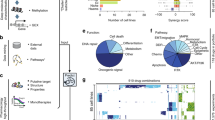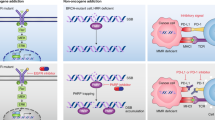Abstract
It has been two decades since cancer was first described as a genetic disease and researchers offered the promise of early diagnosis and targeted therapies. Today, most cancer patients still await life-saving treatments. Genomics and other '-omics' technologies have revealed a complexity among cancers that makes almost any tumour genetically unique; as a consequence, effective targeted therapies might be suitable only for small subgroups of patients. We suggest that by merging and organizing their core competencies, academia, biotechnology companies and the pharmaceutical industry can address existing bottlenecks in anticancer drug discovery and development.
This is a preview of subscription content, access via your institution
Access options
Subscribe to this journal
Receive 12 print issues and online access
$209.00 per year
only $17.42 per issue
Buy this article
- Purchase on Springer Link
- Instant access to full article PDF
Prices may be subject to local taxes which are calculated during checkout



Similar content being viewed by others
References
Bardelli, A. et al. Mutational analysis of the tyrosine kinome in colorectal cancers. Science 300, 949 (2003).
Lynch, T. J. et al. Activating mutations in the epidermal growth factor receptor underlying responsiveness of non-small-cell lung cancer to gefitinib. New Engl. J. Med. 350, 2129–2132 (2004).
Paez, J. G. et al. EGFR mutations in lung cancer: correlation with clinical response to gefitinib therapy. Science 304, 1497–1500 (2004).
Patel, J. D., Pasche, B. & Argiris, A. Targeting non-small cell lung cancer with epidermal growth factor tyrosine kinase inhibitors: where do we stand, where do we go. Crit. Rev. Oncol. Hematol. 50, 175–186 (2004).
Kola, I. & Landis, J. Can the pharmaceutical industry reduce attrition rates? Nature Rev. Drug Discov. 3, 711–715 (2004).
Booth, B. & Zemmel, R. Prospects for productivity. Nature Rev. Drug Discov. 3, 451–456 (2004).
Tolchin, E. Pharmaceutical giants fund start-ups. Drug Discov. Devel. 2, 22 (2004).
Association of University Technology Managers, Inc. (Lori Pressman, ed.) AUTM Licensing Survey. A Survey Summary of Technology Licensing (and Related) Performance for U. S. and Canadian Academic and Nonprofit Institutions, and Patent Management Firms. Northbrook, IL, USA, 2003.
Edwards, M., Murray, F. & Yu, R. Value creation and sharing among universities, biotechnology and pharma. Nature Biotechnol. 21, 618–624 (2003).
Department of Health and Human Services. NIH response to the conference report request for a plan to ensure taxpayers' interests are protected [online], <http://www.nih.gov/news/070101wyden.htm> (2001).
Shreefal, M. The emerging role of academia in commercializing innovation. Nature Biotechnol. 22, 21–24 (2004).
The NIH Almanac [online], <http://www.nih.gov/about/almanac/index.html> (2003).
Leaf, C. Why we're losing the war on cancer — and how to win it. Fortune 76f (22 March 2004).
Booth, B. & Zemmel, R. Quest for the best. Nature Rev. Drug Discov. 2, 838–841 (2003).
Garber, K. US NHGRI launches chemical attack on drug development gap. Nature Biotechnol. 21, 1253–1254 (2003).
Austin, C. P., Brady, L. S., Insel, T. R. & Collins, F. S. NIH Molecular Libraries Initiative. Science 306, 1138–1139 (2004).
DiMasi, J. A., Hansen, R. W. & Grabowski, H. G. The price of innovation: new estimates of drug development costs. J. Health Econ. 22, 151–185 (2003).
Pollack, A. UCSD getting more involved in drug trials. SignOnSanDiego.com [online], <http://www.signonsandiego.com/news/business/biotech/20030731-9999_1b31biotech.html> (31 July 2003).
MIT Press Release. Novartis opens drug research center in MIT's Tech Square [online], <http://web.mit.edu/newsoffice/2002/novartis.html> (6 May 2002).
Smaglik, P. Boston: a magnetic hub. Naturejobs 417, 4–5 (2002).
Schwarz, K. & lquin, J. T. Building the translational highway: toward new partnerships between academia and the private sector. Nature Med. 9, 493–495 (2003).
Mallik, A., Zbar, B. & Zemmel, R. Making pharma alliances work. The McKinsey Quarterly 1 (2004).
Zavoico, G. B. A new culture of drug discovery. NIBR Science (Fall 2004).
Arnst, C. Cancer superdrugs, costly side effects. BusinessWeek 44–46 (21 June 2004).
Sawyers, C. L. Research on resistance to cancer drug Gleevec. Science 294, 1834 (2001).
Booth, B., Glassman, R. & Ma, P. Oncology's trials. Nature Rev. Drug Discov. 2, 609–610 (2003).
Beyond the blockbuster drug. Strategies for nichebuster drugs, targeted therapies and personalized medicine. Business Insights (February 2005).
Kamb, A. What's wrong with our cancer models? Nature Rev. Drug Discov. 4, 161–165 (2005).
CMR International 2003 R&D Compendium, Epsom, UK, 32 (March 2003).
Author information
Authors and Affiliations
Corresponding author
Ethics declarations
Competing interests
The authors declare no competing financial interests.
Related links
Related links
FURTHER INFORMATION
Rights and permissions
About this article
Cite this article
Lengauer, C., Diaz, L. & Saha, S. Cancer drug discovery through collaboration. Nat Rev Drug Discov 4, 375–380 (2005). https://doi.org/10.1038/nrd1722
Issue Date:
DOI: https://doi.org/10.1038/nrd1722
This article is cited by
-
Inhibition of KRAS codon 12 mutants using a novel DNA-alkylating pyrrole–imidazole polyamide conjugate
Nature Communications (2015)
-
Local and global modes of drug action in biochemical networks
BMC Chemical Biology (2009)
-
Insights into US public biotech sector using patenting trends
Nature Biotechnology (2006)
-
Validating cancer drug targets
Nature (2006)
-
Peptide, Peptidomimetic, and Small-molecule Antagonists of the p53–HDM2 Protein–Protein Interaction
International Journal of Peptide Research and Therapeutics (2006)



